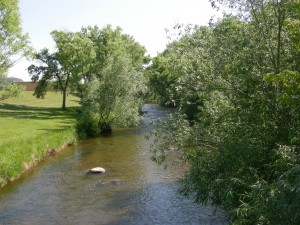Studies have shown that parks and open space increase values for adjacent property by 20 percent. Open space is the number one consideration for small, hi-tech companies looking to relocate, because their highly educated work force is willing to sacrifice high income for high quality of life. Can Rapid City tap the economic growth potential of its parks and open space?
We think it can, without filling that green, open space with the structures, amusements, light, and sound stimuli of so many other aspects of our wired-for-action world.
Quiet, open, natural space is worth something in our hectic lives.
What would New York City be without Central Park? It has been called the “world’s greatest real estate engine” and boasts the highest real estate values on the planet. American landscape architect Frederick Law Olmstead designed Central Park in 1857 after he visited Birkenhead Park in England, the first publicly funded park. Olmstead and the planners of Birkenhead knew that parks can make money. By the time Central Park was completed, property values went up 10 times.
A nationally recognized park expert has visited Rapid City twice in the past two years, telling park professionals, park supporters, and park users that like Central Park, Rapid City’s greenway provides the same kind of “edge,” but we are missing the connection. John Crompton told audiences last year and at a recent Citizen’s Day open house at the Department of Parks and Recreation that our parks have value that people are willing to pay for. We have not taken the opportunity to present the value of that open space in economic terms business leaders and public officials understand. The ribbon of green that is the legacy of the 1972 flood is appreciated, but not understood as an economic driver.
How does open space have economic worth? Economists and natural resource managers have calculated monetary worth of parks in seven areas:
- Increases in property values;
- Stimulation of tourism;
- Providing direct uses like recreation;
- Promoting human health, worth millions in medical care savings;
- Enhancing civic life and community cohesion;
- Reduction of storm water runoff through water retention by trees, grass, creek-side vegetation and other plants; and
- Removal of air pollutants by trees, contributing to air quality.
These factors reported by the Trust for Public Lands for cities like San Diego, Boston, Philadelphia and Sacramento, have meaning in Rapid City.
A one-bedroom apartment facing one of our parks commands anywhere from 50 to 100 percent more per month in rent than a similar apartment without the park view.
The tourism sector of our economy is held up as an engine of business. But it’s the attractions that drive tourism, most of them operated by non-profit or public entities. According to Crompton, publicly funded parks fuel the tourism business. Proponents of parks, professional park designers and managers—not the visitor industry—should claim these numbers as return on investment when making the case for parks. A visitor industry representative at Crompton’s talk observed that tourism promotion does not even name Rapid City’s parks as an attraction.
In 2010, consultants for bike and pedestrian path planning estimated more than 6,000 trips per day on our bike trails—not counting commuter bicycling. We could make the case for health benefits of outdoor activity, the cost of storm water management, or the value of seeing Rapid City listed among American cities with the best air quality.
Making the case is where we have fallen short. No one could argue that our park system is wonderful. As one panelist commented at Crompton’s lecture last year, “We paid a terrible price for the greenway. We need to communicate its value to decision makers.”
So how do we make the case? How do attribute value? Can we create a nexus between those who are paying for parks and those who receive the benefits of the parks?
Here are a few ideas from national experts, local experts, parks professionals, national and local economists, park users and park advocates.
- Some insurance companies give premium advantages to people who take a fitness pledge. Can local health plans connect this to the parks?
- Conservation easements on open space, public or private.
- Incentives in planning and zoning policies that favor cluster developments that incorporate parks and open space.
- Incorporation of incentives and open space requirements in city ordinance, where developer can either set aside land or pay.
- Recognition of developers who have incorporated parks and open space easements.
We are looking forward to hearing what candidates have to say about these ideas, and whether they have ideas of their own.
Come find out. 6:30 p.m. Thursday, May 30. The Journey Museum Theater.

